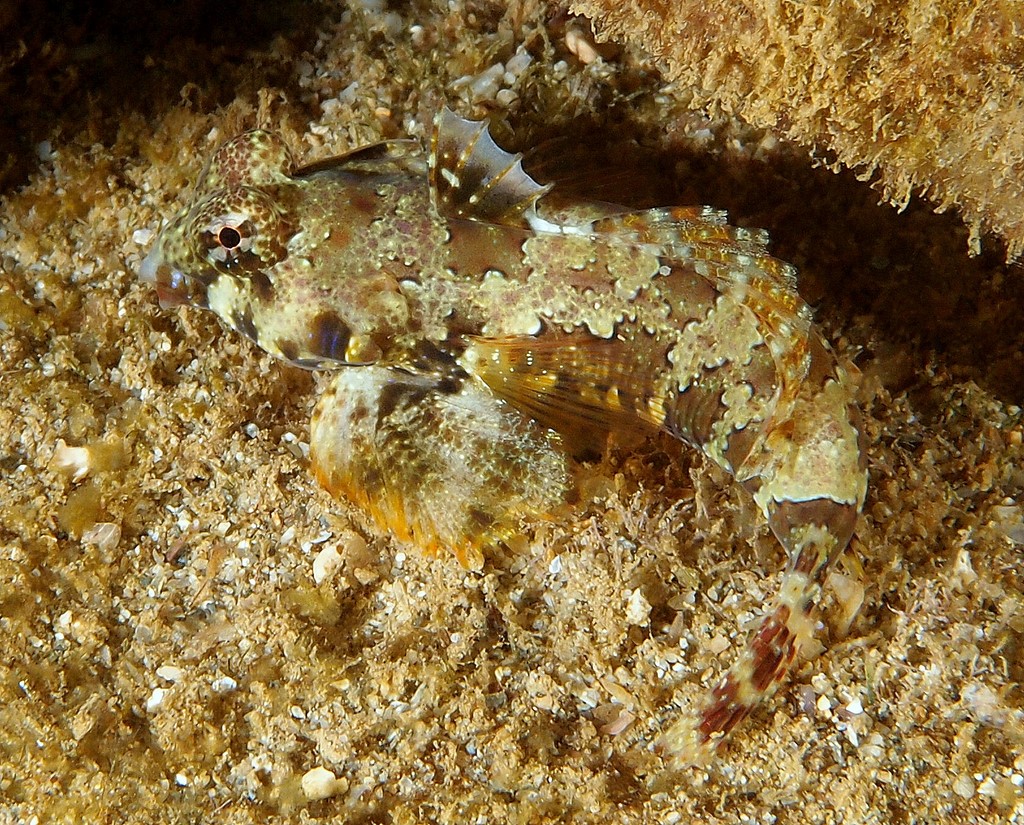SYNCHIROPUS OCELLATUS - (PALLAS, 1770)
Actinopterygii (Gigaclass) > Actinopteri (Class) > Teleostei (Subclass) > Syngnathiformes (Order) > Callionymoidei (Suborder) > Callionymidae (Family) > Synchiropus (Genus)
Poisson-mandarin ocellé, Dragonnet marbré, Marble Dragonet, Ocellated dragonet, Scooter blenny, Øjeplettet fløjfisk, Kouwan-teguri, コウワンテグリ, 眼斑新連鰭䲗,
Synonymes
Callionymus ocellatus (Pallas, 1770)
Neosynchiropus ocellatus (Pallas, 1770)
Callionymus punctulatus (Lacepède, 1800)
Callionymus microps (Günther, 1877)
Synchiropus lili (Jordan & Seale, 1906)
Synchiropus shoe (Okada & Ikeda, 1937)
Synchiropus rhodonotus (Fowler, 1946)
-------------------------
Description
Dorsal spines (total): 4; Dorsal soft rays (total): 8-9; Anal soft rays: 7-9; Pectoral fin rays: 18-23. Soft dorsal and anal fin rays branched; Preopercular spine with a single spinule on dorsal surface; First dorsal fin of males much taller than second dorsal fin, that of females shorter than second dorsal fin. Viewed from above, it is distinctly diamond-shaped with the horizontal pectoral fins located at its widest point. Max. length: 8.9 cm TL. Depth range: 1 - 30 m.
Color
It is brown and tan with a striped or spotted pattern; Males are usually more colorful and have a large sail-like dorsal fin that is bright orange at the base.
Etymology
Synchiropus: from Greek prefix, syn-, symphysis = grown together + from Greek, cheiros = hand + from Greek, opous = foot. Referring to membrane connecting pelvic fin to pectoral fin (also present in Callionymus).
ocellatus: from Latin, ocellatus = having small eyes or an eyelike marking in the form of a spot or ring of color, as on the wing of a butterfly or the tail of a peacock.
Original name: Callionymus ocellatus Pallas, 1770 - Type locality: Ambon Island, Molucca Islands, Indonesia.
Distribution
Indo-West Pacific: eastern Indonesia, east to Philippines, Palau, Chuuk (Federated States of Micronesia) and Pitcairn, north to Izu Islands (Japan), south to northern Australia and New Caledonia.
Poisson-mandarin ocellé, Dragonnet marbré, Marble Dragonet, Ocellated dragonet, Scooter blenny, Øjeplettet fløjfisk, Kouwan-teguri, コウワンテグリ, 眼斑新連鰭䲗,
Synonymes
Callionymus ocellatus (Pallas, 1770)
Neosynchiropus ocellatus (Pallas, 1770)
Callionymus punctulatus (Lacepède, 1800)
Callionymus microps (Günther, 1877)
Synchiropus lili (Jordan & Seale, 1906)
Synchiropus shoe (Okada & Ikeda, 1937)
Synchiropus rhodonotus (Fowler, 1946)
-------------------------
Description
Dorsal spines (total): 4; Dorsal soft rays (total): 8-9; Anal soft rays: 7-9; Pectoral fin rays: 18-23. Soft dorsal and anal fin rays branched; Preopercular spine with a single spinule on dorsal surface; First dorsal fin of males much taller than second dorsal fin, that of females shorter than second dorsal fin. Viewed from above, it is distinctly diamond-shaped with the horizontal pectoral fins located at its widest point. Max. length: 8.9 cm TL. Depth range: 1 - 30 m.
Color
It is brown and tan with a striped or spotted pattern; Males are usually more colorful and have a large sail-like dorsal fin that is bright orange at the base.
Etymology
Synchiropus: from Greek prefix, syn-, symphysis = grown together + from Greek, cheiros = hand + from Greek, opous = foot. Referring to membrane connecting pelvic fin to pectoral fin (also present in Callionymus).
ocellatus: from Latin, ocellatus = having small eyes or an eyelike marking in the form of a spot or ring of color, as on the wing of a butterfly or the tail of a peacock.
Original name: Callionymus ocellatus Pallas, 1770 - Type locality: Ambon Island, Molucca Islands, Indonesia.
Distribution
Indo-West Pacific: eastern Indonesia, east to Philippines, Palau, Chuuk (Federated States of Micronesia) and Pitcairn, north to Izu Islands (Japan), south to northern Australia and New Caledonia.
Biology
Inhabits sandy areas of lagoon and seaward reefs. Also in sheltered rocky reef habitats in few meters depth, usually in small loose groups. Occurs in rubble and algal turfs. Feeds on small benthic invertebrates.
Similar species
Synchiropus moyeri (Zaiser & Fricke, 1985) - Reported from Eastern Indian Ocean, western Pacific: central Indonesia east, to Palau, Mariana Islands, Marshall Islands and New Ireland (Papua New Guinea), north to Izu Islands (Japan), south to northern Australia. Possibly east to Marquesas Islands.
Inhabits sandy areas of lagoon and seaward reefs. Also in sheltered rocky reef habitats in few meters depth, usually in small loose groups. Occurs in rubble and algal turfs. Feeds on small benthic invertebrates.
Similar species
Synchiropus moyeri (Zaiser & Fricke, 1985) - Reported from Eastern Indian Ocean, western Pacific: central Indonesia east, to Palau, Mariana Islands, Marshall Islands and New Ireland (Papua New Guinea), north to Izu Islands (Japan), south to northern Australia. Possibly east to Marquesas Islands.
Last update: 4, April 2024
